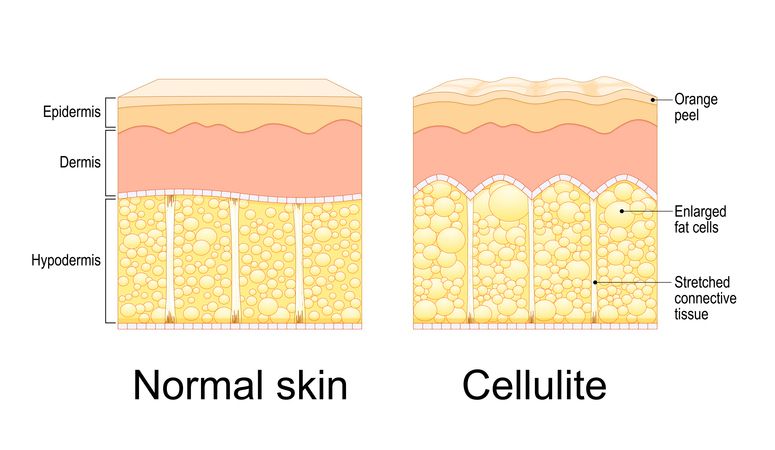Author: Natalie Ng|Updated: 9 May 2025
As you age, your skin starts to change. It slowly loses firmness and elasticity, which leads to sagging skin—especially around the cheeks, jawline, and neck. This happens because your body produces less collagen and elastin, two proteins that keep your skin smooth, tight, and supported. These changes usually begin in your 30s and become more noticeable over time. Other things also speed up the skin aging process—like sun exposure, pollution, and certain lifestyle habits. Over the years, these factors affect the deeper layers of the skin, weaken connective tissue, and cause volume loss in areas that used to feel full and firm. Understanding how aging affects your facial structure, skin tone, and collagen production is the first step toward finding the right ways to support your skin. Whether you're curious about dermal fillers, skin tightening, or non-surgical treatments, learning about the causes of saggy skin can help you make more informed choices. Keep reading to learn what’s really happening beneath the surface and how you can improve skin health without guesswork.

Behind The Facial Skin Structure
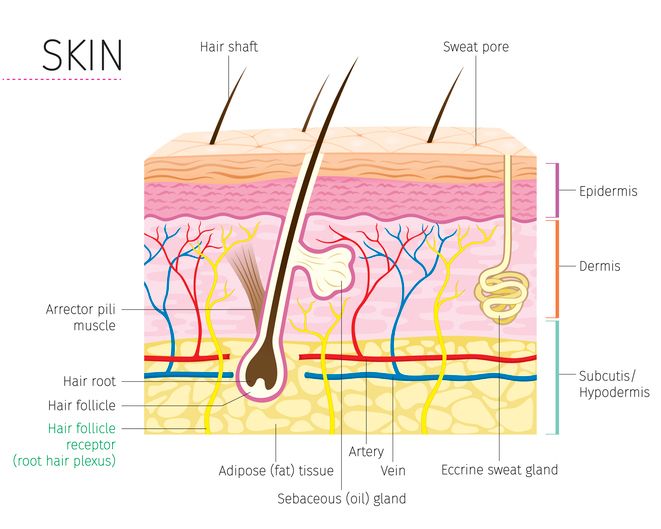
Epidermis: The Surface Layer
The epidermis is the outermost layer. It protects your skin from the environment, including sun exposure and pollution. This layer is where skin cells constantly renew themselves through natural turnover. A healthy daily skincare routine and sun protection help keep this layer working properly.
Dermis: Where Strength and Elasticity Begin
Beneath the surface is the dermis. This layer contains collagen and elastin fibers that give your skin its strength and stretch. Over time, collagen production slows down, and the skin elasticity starts to fade. That’s when signs like wrinkles, fine lines, and sagging skin become more visible. The dermis also holds blood vessels and nerve endings, which support skin health and your outward appearance.
Hypodermis: The Foundation of Facial Volume
The deepest layer is the hypodermis. It’s made of fat pads that give shape to your face and help maintain a youthful appearance. As you age, this layer gets thinner, which leads to volume loss, changes in your face shape, and saggy skin—especially around the jawline, nasolabial folds, and double chin areas.
Changes in these layers are part of the skin aging process. They affect your facial structure, skin tone, and how your facial contours look over time.

Collagen and Elastin: Key Proteins Of Your Facial Skin
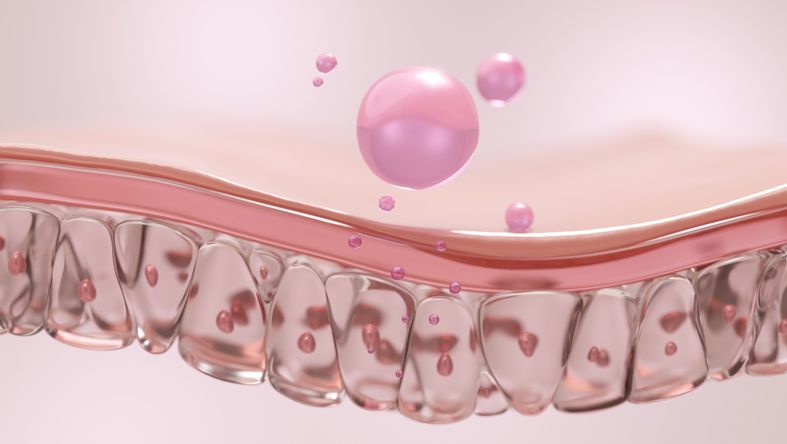
Structure and Support Functions
Collagen and elastin are the two main proteins that give your facial skin its strength and flexibility. Collagen builds a firm internal structure by forming a dense network of collagen fibres. This network supports the deeper layers of the skin and helps maintain its shape. Elastin works alongside collagen by allowing the skin to stretch and return to its original position. Together, these proteins form the foundation of healthy skin structure and help maintain a smooth, youthful appearance.
Collagen gives firmness. Elastin gives flexibility. Without them, skin loses its ability to stay tight and bounce back after movement, leading to wrinkles, fine lines, and sagging skin.
Production Changes With Age
Collagen production starts to slow in your late 20s or early 30s. As this happens, your skin becomes thinner, weaker, and more prone to saggy skin and facial volume loss. Elastin fibres also break down over time, reducing your skin’s ability to stretch and recover from everyday facial movements.
This natural slowdown is made worse by environmental factors like sun exposure, smoking, and poor nutrition. These factors break down collagen and elastin faster than your skin can rebuild them. Over time, the skin develops moderate skin laxity and starts to show visible signs of aging — especially around the eyes, cheeks, and jawline.
Preventing Protein Loss Naturally
While collagen and elastin loss is part of the skin aging process, some everyday habits can help preserve these proteins and slow down sagging facial skin.
• Eat more foods with vitamin C, such as citrus fruits and leafy greens, to support collagen synthesis
• Include protein-rich foods like fish, eggs, and legumes to give your body the building blocks it needs for collagen production
• Protect your skin from sun damage by wearing sunscreen daily and limiting sun exposure
• Stay hydrated and eat antioxidant-rich foods like green tea, berries, and nuts to protect your collagen and elastin fibres from breakdown
Simple changes in your daily routine can help stimulate collagen production and keep your skin healthy and firm for longer.
Read More
Book Now to Experience
Ultra V Lift Pro Non-Surgical Instant Facelift Treatment
1 Minute Self-Registration
Date should not be before minimal date

Natural Age-Related Changes in Facial Fat Pads

Volume Loss and Downward Shift
As part of the natural skin aging process, the fat pads in your face gradually lose volume and start to shift downward. These fat pads are located beneath the skin and help maintain facial contours, structure, and fullness. When you're younger, they give your cheeks a rounded, lifted look. But as you age, these pads become smaller and move lower.
This shift leads to changes in your face shape. The cheeks flatten, the area under the eyes may appear hollow, and the jawline can lose its definition. You may also notice deeper nasolabial folds and early signs of jowls, both caused by the repositioning of fat and weakening of support structures.
How Fat Pads Affect Facial Structure
Your face contains several separate fat compartments. Each one supports a specific area. With time, these compartments lose their tight connections and begin to move apart. This separation changes how your facial volume is distributed.
• The malar fat pad (in the mid-cheek area) descends, making the under-eye area look tired or sunken
• The temples and forehead become more hollow due to fat loss in the upper face
• Lower areas, such as around the chin and jawline, may appear fuller or saggy due to downward fat movement
These changes contribute to sagging facial skin, reduced skin tone, and an altered facial structure. While they are normal signs of aging, understanding them can help you choose non-surgical skin tightening options or dermal fillers to restore volume and support.

Environmental Factors Affecting Skin Firmness

1. Sun Exposure and UV Damage
Sun exposure is one of the leading causes of early skin sagging. Ultraviolet (UV) rays penetrate deep into the skin and break down collagen and elastin fibers. Over time, this damage reduces skin elasticity and causes visible signs of aging such as wrinkles, dark spots, and sagging skin. Daily sun protection with broad-spectrum sunscreen is essential to protect skin collagen and maintain skin structure.
2. Air Pollution and Skin Stress
Pollution particles in the air can stick to your skin and break through its outer layer. This leads to inflammation and oxidative stress, which weakens connective tissue and speeds up collagen loss. Living in polluted environments without proper skin care can accelerate the appearance of loose skin and uneven tone.
3. Dry Environments and Dehydration
Exposure to dry air, indoor heating, and air conditioning removes moisture from your skin. Without enough hydration, the skin barrier becomes weaker, and skin tone may appear dull. Dryness also reduces skin elasticity and makes fine lines and sagging more noticeable. Keeping skin hydrated helps protect the deeper layers and slows the visible signs of aging.
4. Smoking and Free Radical Damage
Smoking exposes your skin to harmful chemicals that lower blood flow, reduce oxygen delivery, and damage skin cells. It increases the production of free radicals, which break down collagen and elastin faster. This leads to earlier wrinkles, sagging facial skin, and poor overall appearance. Even secondhand smoke can contribute to skin aging.
Book Now to Experience
Ultra V Lift Pro Non-Surgical Instant Facelift Treatment
1 Minute Self-Registration
Date should not be before minimal date

Impact of Genetics On Facial Aging

How Genetics Shape Skin Aging
Your genetic makeup influences how your facial skin changes over time. This includes how quickly you lose collagen, how your fat pads are distributed, and how well your skin bounces back from movement. These inherited traits affect everything from your facial structure to the way your skin responds to sun damage and volume loss.
You might notice that you age in a similar way to your parents or grandparents. For example, if your family tends to develop jowls or deep nasolabial folds earlier in life, you're more likely to see those same signs.
Genetic Factors and Their Impact
| Genetic Factor | Impact on Skin Aging |
|---|---|
| Collagen Type | Affects skin elasticity and firmness |
| Melanin Levels | Influences how well your skin resists sun damage |
| Fat Distribution | Determines where and how volume loss appears |
While you can't change your DNA, you can adjust your skincare and lifestyle choices based on what you're likely to experience. Early use of targeted treatments—like non surgical skin tightening or dermal fillers—can help reduce saggy skin and maintain your facial contours longer.

Common Signs of Facial Skin Laxity

1. Deeper Nasolabial Folds
One of the early signs of facial skin laxity is the deepening of nasolabial folds. These are the lines that run from the sides of your nose to the corners of your mouth. As skin loses elasticity and volume shifts, these folds become more visible—even when your face is at rest.
2. Jowls Along the Jawline
As collagen production slows and connective tissue weakens, the lower part of the face begins to sag. This leads to jowls—soft, sagging skin that forms along the jawline. Jowls reduce jaw definition and can change the overall shape of your face.
3. Under-Eye Hollows and Loose Skin
Fat loss beneath the eyes, combined with thinner skin, can cause the under-eye area to look sunken or puffy. This results in eye bags and contributes to a tired appearance. The skin in this area is delicate and often shows signs of aging earlier than other parts of the face.
4. Flattening and Descent of the Cheeks
Facial fat pads in the mid-face area naturally descend with age. This causes the cheeks to appear flatter and lower, reducing the fullness that’s associated with a youthful appearance. These changes also make other signs of aging, like nasolabial folds, more noticeable.
Book Now to Experience
Ultra V Lift Pro Non-Surgical Instant Facelift Treatment
1 Minute Self-Registration
Date should not be before minimal date

Prevention Strategies for Maintaining Skin Elasticity
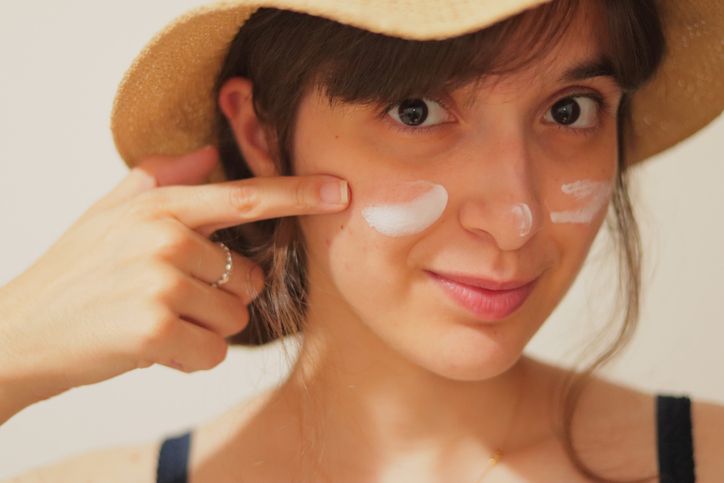
1. Daily Sun Protection
Sun exposure is one of the biggest contributing factors to collagen loss. To protect your skin, apply a broad-spectrum SPF 30 or higher every day—even when it’s cloudy. Wear protective clothing and avoid direct sun during peak hours. This helps prevent sun damage that leads to early sagging and reduced skin elasticity.
2. A consistent skincare routine
Slow visible signs of skin aging by using products with active ingredients that support collagen production and improve skin texture:
• Retinoids stimulate skin cell turnover and strengthen collagen fibres
• Peptides support connective tissue and firm the skin
• Vitamin C helps stimulate collagen production and protects against oxidative stress
• Hyaluronic acid keeps the skin hydrated and supports skin structure
Apply products gently using upward motions to avoid pulling on the skin.
3. Healthy Lifestyle Habits
What you eat and how you live affects your skin deep beneath the surface. Support your skin’s elasticity from the inside out:
• Stay hydrated to keep the skin plump and prevent dryness
• Eat a healthy diet rich in antioxidants, omega-3 fatty acids, and protein
• Get 7–8 hours of sleep each night to allow your skin to repair
• Reduce sugar and processed foods, which can speed up collagen breakdown
• Avoid smoking and limit alcohol—both contribute to skin laxity and poor skin tone
4. Facial Movement and Circulation
Simple habits like regular facial massage and facial exercises can help improve blood flow and maintain facial muscle tone. These practices support firmer-looking skin and may help reduce the appearance of sagging over time.

Treatment Options for Facial Sagging
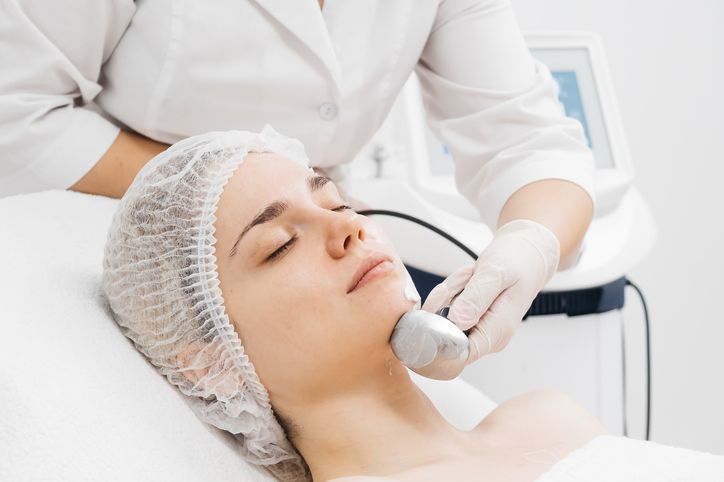
Non-Surgical Face Lifting Treatments
If you're noticing sagging skin but want to avoid surgery, several non invasive treatments can help lift and firm the face. These options focus on stimulating new collagen and improving skin elasticity without cutting or stitching.
• High intensity focused ultrasound (HIFU) uses targeted sound waves to heat the deeper layers of skin. This stimulates collagen production and improves firmness over time.
• Radiofrequency treatments apply controlled heat to tighten existing collagen and encourage new growth in the dermis.
• Thread lifts involve placing dissolvable threads under the skin to gently lift sagging areas. They also trigger the body to produce more collagen in the treated areas.
• Dermal fillers help replace volume that has been lost in the cheeks, temples, or jawline. This adds structure and improves overall facial contours.
• Injectables, such as neurotoxins, smooth wrinkles and reduce the appearance of sagging by relaxing certain facial muscles.
These treatments are usually done in under an hour and require little to no recovery time. Results can last from a few months up to six months or more, depending on the specific procedure and your skin's response.
Book Now to Experience
Ultra V Lift Pro Non-Surgical Instant Facelift Treatment
1 Minute Self-Registration
Date should not be before minimal date

Lifting Sagging Skin with New Beauty’s Ultra V Lift Pro Non-Surgical Instant Facelift
As facial skin ages, the loss of collagen and elastin, shifting fat pads, and weakening facial muscles lead to visible sagging—especially around the cheeks, jawline, and under the chin. While skincare and healthy habits help slow the skin aging process, targeted treatments are often needed to restore firmness. This is where Ultra V Lift Pro Non-Surgical Instant Facelift Treatment offers a practical solution.
What Is Ultra V Lift Pro?
Ultra V Lift Pro is a non-invasive treatment designed to improve sagging facial skin without surgery or recovery time. It uses patented Thermal Diffusion Treatment (TDT™) technology to deliver controlled ultrasonic thermal energy deep into the SMAS layer—the same layer addressed in surgical facelifts.
By reaching this layer, the treatment stimulates collagen production and elastin growth. This helps strengthen connective tissue, improve skin tone, and restore skin elasticity. Over time, this process reduces skin laxity and improves facial structure.
How the Treatment Works
1. TDT™ technology emits ultrasonic energy into the deeper layers of facial skin.
2. The heat spreads evenly across the SMAS layer, tightening facial muscles while stimulating new collagen and elastin production.
3. The skin gradually appears firmer, more lifted, and more defined, with improvements continuing over the following weeks.
Benefits of Ultra V Lift Pro
• Non-surgical and non-invasive: No cuts, no injections, and no need for anesthesia
• Triggers natural collagen and elastin production for long-lasting improvement
• Targets multiple areas: jawline, double chin, cheeks, and nasolabial folds
• Suitable for all skin types, including oily or sensitive skin
• Safe and painless: only mild warmth is felt during treatment
• No downtime: resume daily activities immediately after the session
• Helps tighten loose skin and improve facial contours gradually and naturally
Ultra V Lift Pro is a strong option for those with moderate skin laxity who want visible results without undergoing invasive procedures. It complements other skin tightening approaches and fits well into a routine aimed at reversing visible signs of skin aging.
Book Ultra V Lift Pro today and take the next step toward smoother, firmer, and younger-looking skin—without surgery or downtime.
New Beauty's Ultra V Lift Pro Non-Surgical Instant Facelift Treatment
Building an Anti-Sagging Skincare Routine

Even with non-surgical treatments like Ultra V Lift Pro, your daily skincare routine plays an important role in maintaining skin elasticity and preventing sagging facial skin. A targeted, consistent approach helps support collagen production and keeps your skin structure strong over time.
Key Products to Include
• Retinoids: Increase skin cell turnover and support collagen regeneration
• Peptides: Help rebuild and maintain connective tissue
• Vitamin C: Supports collagen synthesis and protects against environmental damage
• Hyaluronic acid: Keeps the skin hydrated and plump, improving skin tone and texture
Use a gentle cleanser, apply products in upward motions, and don’t forget daily sun protection. SPF 30+ helps prevent sun damage that breaks down collagen fibres and accelerates sagging.
Daily Prevention Tips
• Cleanse and moisturize morning and night
• Use active ingredients consistently to support long-term skin health
• Stay hydrated and follow a balanced, healthy diet
• Get regular sleep and avoid habits like smoking that weaken skin collagen
• Practice gentle facial massage or exercises to promote blood flow and maintain facial muscle tone
Pairing a simple skincare routine with healthy habits—and adding treatments like Ultra V Lift Pro when you need a boost—can make a big difference over time. Whether you're just starting to notice some early sagging or you're dealing with more noticeable changes, small things done consistently really do add up. Staying on top of your skincare, protecting your skin from the sun, eating well, and keeping your skin hydrated all help keep things firm, smooth, and lifted. And if you ever feel like your skin needs a little extra support, you've got great non-surgical options to choose from.
Book Now to Experience
Ultra V Lift Pro Non-Surgical Instant Facelift Treatment
1 Minute Self-Registration
Date should not be before minimal date
FAQ
At What Age Does Facial Sagging Typically Become Noticeable?
You'll likely notice facial sagging between ages 35-40, though it can start earlier. Your skin's collagen and elastin production slows down in your late 20s, setting the stage for future changes. Everyone's timeline differs based on genetics, lifestyle, and sun exposure. Don't let society's beauty standards define you - these natural changes reflect your life's journey and experiences.
Can Facial Exercises Really Help Prevent or Reduce Sagging Skin?
While some beauty gurus swear by facial exercises, science tells a different story. You won't find solid evidence that facial workouts prevent sagging, and they might actually contribute to wrinkles from repetitive movements. Instead, you can take control by protecting your skin with sunscreen, maintaining good hydration, and eating a nutrient-rich diet. If you're seeking real results, proven treatments like retinoids and professional skin treatments offer more reliable solutions.
Are Facial Massage Tools Worth Investing in for Skin Tightening?
While facial massage tools can boost circulation and help with lymphatic drainage, they won't dramatically tighten your skin. You'll get some temporary benefits like reduced puffiness and a healthy glow, but don't expect miracles. If you're interested, start with affordable options like jade rollers or gua sha tools. Save your money for more proven treatments like retinoids, sunscreen, and professional treatments if you're seeking significant skin-tightening results.
How Long Do Surgical Face-Lifting Results Typically Last?
Facelift finesse typically delivers durable, dramatic results that'll last 8-10 years. You'll notice the most substantial transformation in the first five years, though your face won't suddenly fall after that point. Instead, you'll continue aging naturally from your new starting point. Your lifestyle choices, including sun protection, smoking habits, and skincare routine, can markedly impact how long you'll maintain your refreshed appearance.
Does Weight Loss Make Facial Sagging Worse or Better?
You'll notice different effects on your face depending on how much weight you lose and how quickly. Gradual weight loss can help your skin better adapt and maintain elasticity. However, rapid or significant weight loss might increase facial sagging because your skin doesn't have time to adjust to your new contours. If you're under 40, your skin's typically more resilient and bounces back better.
Recommended Articles
COPYRIGHT© NEW BEAUTY MANAGEMENT LIMITED 2025. ALL RIGHT RESERVED.

